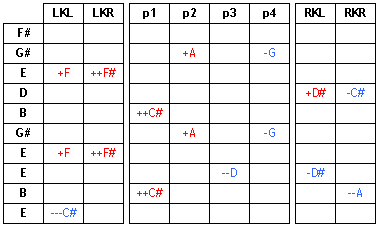An Introduction and Overview
In the late 20th century, a phenomenon known as Sacred Steel started creating quite a buzz in the music world. Developed in African-American churches, Sacred Steel music uses the steel guitar as the primary lead instrument. This style of playing developed independently of the mainstream steel community. As its players evolved, they developed pedal steel tunings to meet the demands of their music.
Several of the most popular Sacred Steel players play Carter steel guitars. The information in this article came from careful study of their copedents as listed on the Carter web site, and from my own experimentation with variations on the E7th tuning.
All pedal steel tunings have evolved from similar lap steel tunings, and the E7th is no exception. Here are a few variations of the E major and E7th lap steel tunings:
1 E E E 1 E E
2 B B D 2 B D
3 G# G# B 3 G# B
4 E E G# 4 E G#
5 B D E 5 D E
6 E B B 6 B D
7 G# B
8 E E
While these tunings are wonderfully expressive for single-voice leads, they tend to come up short in the chord department. The modern Sacred Steel style includes a lot of rhythm “comping”, which requires at least a full set of majors, minors and sevenths. This brings us to the basic 8 strings, 4 pedals and 3 knee levers that are included in most Sacred Steel E7 copedents:

The most strikingly original thing about this tuning is the doubling of the middle E string. The reasoning behind it is a brilliant strategy for playing rhythm. When you want a major or minor triad, the doubled string allows you to strum across the strings and still get a triad. When you want a denser chord (6ths, 7ths, 9ths and diminished chords, for example), you raise one E and lower the other.
Beyond this simple strategy, players add strings and changes to fit their needs. Chuck Campbell, for example, adds a bass B and an even lower bass E to cover the bass parts in his band. Lonnie Bennett includes some unusual pedals to get jazz chords similar to the standard C6th. Robert Randolph fills the gap in the low end with a G# string. Some players include a high G# like the country E9th, and some (including Randolph and Campbell) have added “out of order” strings on top to make fast melody work easier.
Below is a chart that shows 14 strings of the E7th, along with most of the pedal and knee lever changes used by Chuck Campbell and Robert Randolph. The 8 string copedent from above is highlighted in yellow.

In designing a variation for my own use, I knew that I would be called on to play country music from time to time. The high G# and F# seemed necessary to me for that. Also, I have 23 years invested in E9th knee lever reflexes that I didn’t want to change. Here’s what I ended up with:

If you want to play single line blues leads, you can pretty much learn to do that on any tuning. But if you really want to get into some heavy rhythm work, the Sacred Steel E7th is the way to go!
© 2001 by Bob Lee